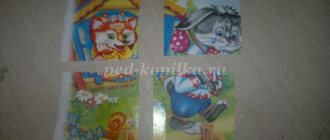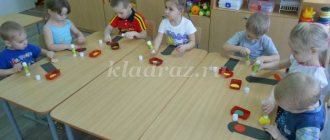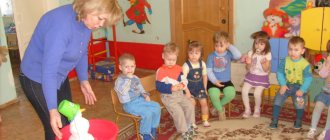Notes on household work “Toys love cleanliness” (junior group)
Branch of MBDOU "Kindergarten No. 43" - "Kindergarten No. 40" Slavgorod
Abstract
Organization of economic and labor activities in the second junior
Topic: “Toys love cleanliness”
Teacher Starosvet Marina Aleksandrovna
Slavgorod
Target.
Create conditions for organizing household work for children of primary preschool age.
Tasks:
Teach children to correctly perform individual actions and, based on their assimilation, form elementary work activities.
Develop a desire to work.
Help the child develop interest in adult activities.
Cultivate a desire to participate in feasible work and the ability to overcome minor difficulties.
Preliminary work.
Reading the fairy tale “Moidodyr” by K. Chukovsky, “The Dirty Girl” by A.L. Barto.
Equipment:
aprons, basins, napkins, rubber toys.
Progress of activities:
Guys, today we are going on a trip with you.
Children enter the group and see a mess, scattered toys.
- What happened here?
-Who did all this? (The boy Nekhachukha came to us and played, but scattered his toys and didn’t put them back)
-Has it become beautiful in our group?
-What do guys need to do? (put the toys back in their places)
Children restore order in the group, put toys in their places.
The teacher reads a poem:
Let toys be friends with us
We will not offend them
Let's play and then
We'll put everything back in place.
What a great job you guys are, how beautiful you have become, you have brought order to the group, the toys are in their places. We can go on a trip. It sounds like you're crying.
- Oh, who’s crying? Children look for and find a basket with dirty toys.
-What happened to you. (we look at toys).
-Who guys guessed it? (they are dirty).
- How can we help them? (wash)
We have these basins, now we will pour water into them and wash the toys. I am confident that you will cope with this task.
— Guys, what should you do before washing your toys so as not to get your clothes wet?
-We put on our aprons and rolled up our sleeves. Now let everyone choose a toy to wash. Take a toy, place it on the table near the basin, take a napkin, wet it with water, squeeze it out a little, take soap and lather it with soap. Rub the toy with a soapy napkin. Rinse the toy in clean water and place it to dry
napkin. While our toys are drying, we will clean up the table, wring out the napkins and put them on display, take off our aprons and dry our hands with a paper towel.
If you've finished, come to me. Look at the toys, what have they become? (clean).
Tell me, Veronica, how did you make the toy clean?
Guys, did you enjoy working? (Yes).
And because you helped the toys become clean again, they want to play with you and gave me soap bubbles. games with soap bubbles.
Forms of organization of child labor
The work of preschool children in kindergarten is organized in three main forms: assignments, compulsory work and collective labor activity.
Assignments are tasks that the teacher occasionally assigns to one or more children, taking into account their age and individual abilities, experience and learning goals.
Tasks can be short or long, individual or general, simple (with a simple specific action) or more complex, with a chain of sequential actions.
Carrying out work assignments helps children develop an interest in work and a sense of responsibility for the assigned task. The child must focus his attention, show willpower to complete the task and inform the teacher when it is completed.
In younger groups, tasks are individual, specific and simple and involve one or two actions (put a spoon on the table, bring a watering can, remove clothes from a doll for washing, etc.). Such elementary tasks involve children in activities aimed at the benefit of the team, in conditions where they are not yet able to independently organize the work.
In the middle group, the teacher instructs the children to wash doll clothes, wash toys, sweep paths, and rake sand into a pile. These tasks are more difficult, since they contain not only several actions, but also elements of self-organization (prepare a place to work, determine the order of work, etc.).
In the older group, individual tasks are organized in work where children's skills are not sufficiently developed, or when they are learning new skills. Individual tasks are also given to children who need additional training or particularly close supervision (when the child is inattentive and often distracted), that is, when it is necessary to individualize methods of influence.
In the preschool group, children must demonstrate the necessary self-organization skills when performing general tasks, and therefore the teacher is more demanding of them, moving from explanation to control, to reminder.
Duty duty is an organizational form of child labor that involves mandatory work performance, focused on serving the team. Children are alternately involved in various types of services, which ensures their systematic participation in the work. The distribution and rotation of duties is carried out on a daily basis. Debt has great educational value. They put the child in a state of obligatory performance of certain work necessary for the team. This allows children to develop responsibility for the group, a caring attitude and an understanding of the importance of their work for everyone.
In the younger group, while running errands, children acquired the skills necessary to set the table and became more independent in completing work. This allows the middle group to introduce canteen duty at the beginning of the year. One person works at each table every day. In the second half of the year, children are on duty to prepare for classes. In older groups, duty in natural corners is introduced. The attendants change daily, each of the children systematically participates in all types of services.
Collective work is the most complex form of organizing children's work. It is often used in the senior and preparatory groups of kindergarten, when skills become more stable and the results of work have practical and social significance. Children already have sufficient experience with various types of services and assignments. Expanding opportunities allows the teacher to solve more complex tasks of labor education: teaching children to negotiate upcoming work, work at the right pace, and complete a task at a certain time. In the older group, the teacher uses a form of uniting children such as joint work, when children are given a common task for all, and at the end of the work the overall result is added up.
In the preparatory group, joint work takes on special importance when children are dependent on each other in the process of work. Working together gives the teacher the opportunity to develop positive forms of communication between children: the ability to politely address each other with requests, agree on joint actions, and help each other.
The importance of a collective form of work for the formation of a child’s personality
Showing social activity, each student perceives the team as an arena for self-expression and self-affirmation as an individual. Thanks to pedagogical support of social life, the desire to assert oneself in the eyes of one’s own and peers finds favorable soil in the team. Only in a group are such important personality traits as self-esteem, self-acceptance and self-respect formed, that is, acceptance or non-acceptance of one’s own person.
The educational team, as defined by I.F. Kozlov, who specifically studied Makarenko’s work, is a scientifically organized system for educating children’s lives. The organization of collective educational-cognitive, value-oriented activities and communication creates conditions for the formation and implementation of intellectual and moral freedom. Only in the activities of collective life are the intellectual and moral orientations of an individual, his civic position, and a set of socially significant skills and abilities formed.
The role of the team in organizing the work activities of children cannot be replaced by anything. In a team setting, this stimulates the manifestation of mutual responsibility for the final results of work and mutual assistance.
The formation of collective planning skills contributes to the emergence in children of a desire for self-control, independent improvement of methods and skills necessary for the implementation of an independent plan, and an increased sense of responsibility. And the result of collective planning is the high quality of the jointly obtained result of work activity.
Successful achievement of a goal largely depends on the ability to control one’s own activity. Children 3-4 years old do not notice mistakes in their work and consider it good, regardless of how and what result is achieved. They are critical of the work of their peers. At the age of 5-7 years, preschoolers try to correctly evaluate their work, although they do not notice all the mistakes, but only the most serious ones. They are interested in the quality of work. Therefore, they turn to an adult with questions about the correctness and quality of their own work activities.
The teacher invites all children to bake cookies, plant onions, wash the dolls’ clothes (the number of children can be very different: from 2-3 to 6-7, and in older groups even more). Each of the children is given a specific task, for example: take a piece of dough, roll it out and cut out cookies with a cookie cutter, or take several onions, let the teacher show which path, marked with a line, needs to be planted, and start working, etc.
Children work side by side. But when the work process is completed, the mentor sums up the results. Thus, he can point out the advantage of teamwork: Everyone did a little work, but together they achieved a lot. This is the simplest join; only the results are joined. But in this task, the teacher tells the children as they work: “We must try to keep up with others. Don't keep your friends waiting. And taking into account the capabilities and level of ability of a particular child, he will provide such an amount of work for everyone that everyone can do the work at approximately the same time.
This form of association is a transition from working side by side to working together.
As children gain experience in participating in work and master skills, as well as the rules for organizing their own work activities, as their development of certain principles of hard work increases (that is, as they solve previously set educational tasks), the teacher begins to move on to more complex tasks.
It is important to develop in children the beginnings of collectivism, the ability to work together, help each other, see the difficulties of comrades and offer their services, seek help from peers, rejoice at their successes, overall results of work, and so on. These tasks are most successfully solved when children work together.



